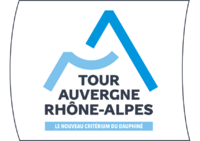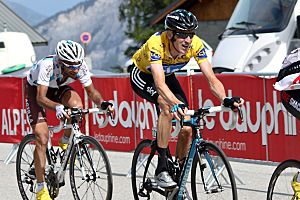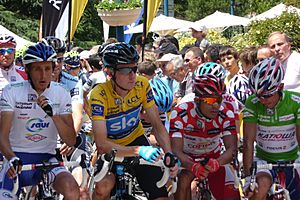Critérium du Dauphiné facts for kids
 |
|
| Race details | |
|---|---|
| Date | Early June |
| Region | Rhône-Alpes, France |
| Local name(s) | Critérium du Dauphiné |
| Nickname(s) | The Dauphiné |
| Discipline | Road |
| Competition | UCI World Tour |
| Type | Major one week stage race |
| Organiser | Amaury Sport Organisation |
| Race director | Bernard Thévenet |
| History | |
| First edition | 1947 |
| Editions | 77 (as of 2025) |
| First winner | |
| Most wins | (3 wins each) |
| Most recent | |
The Tour Auvergne-Rhône-Alpes is a big annual bike race in France. Until 2025, it was known as the Critérium du Dauphiné. Before 2010, it was called the Critérium du Dauphiné Libéré. This exciting road race takes place in the beautiful Dauphiné region, in the southeast of France.
The race lasts for eight days in early June. It's a very important event in the UCI World Tour calendar. Many cyclists use it to get ready for the famous Tour de France in July. It's like a major warm-up race!
The Dauphiné Libéré newspaper started the race in 1947. They were the main sponsor until 2009. Since 2010, ASO has organized the race. ASO also organizes other big French cycling events, like the Tour de France.
Because the race is in the Rhône-Alpes region, which is part of the French Alps, it has many challenging mountain climbs. Famous climbs from the Tour de France, like Mont Ventoux and Col du Galibier, are often part of this race. This means that cyclists who are good at climbing often do well here. Five riders have won the race three times each: Nello Lauredi, Luis Ocaña, Charly Mottet, Bernard Hinault, and Chris Froome.
Contents
Race History
How the Race Started
The Le Dauphiné libéré newspaper created this race in 1947. They wanted to help their newspaper reach more people. After World War II, cycling was starting up again. The newspaper, based in Grenoble, decided to create a bike race. It would cover the Dauphiné region.
The race was named after the newspaper and held in June. This was just before the Tour de France. A Polish rider named Edward Klabiński won the very first race.
Because of its mountain routes and timing, French cyclists used it to prepare for the Tour de France. Famous French riders like Jean Robic and Louison Bobet used the Dauphiné Libéré as their final big race before the Tour.
The race didn't happen in 1967 and 1968. In 1969, it joined with another race called the Circuit des Six-Provinces-Dauphiné. For many years, the newspaper and ASO worked together to organize it. In 2010, the newspaper gave all the organizing to ASO. The race name then became shorter, Critérium du Dauphiné.
A Top Cycling Event

In the 1990s, the race became a very high-level event. It was one of the most important stage races after the biggest ones, called Grand Tours. In 2005, it became part of the first UCI Pro Tour. Then, in 2011, it joined the UCI World Tour, which is the top series of races today.
The Critérium du Dauphiné is special because all four riders who won the Tour de France five times also won this race. These legends are Jacques Anquetil, Eddy Merckx, Bernard Hinault, and Miguel Induráin.
Many riders have won both this race and the Tour de France in the same year. This shows how important the Dauphiné is for Tour de France preparation. Some of these riders include Louison Bobet (1955), Eddy Merckx (1971), Bernard Hinault (1979 and 1981), Bradley Wiggins (2012), Chris Froome (2013, 2015, 2016), Geraint Thomas (2018), Jonas Vingegaard (2023), and Tadej Pogačar (2025).
In 2025, ASO announced a new name for the race starting in 2026. It will be called Tour Auvergne-Rhône-Alpes. This is because of a new partnership with the Auvergne-Rhône-Alpes region, where the race takes place.
Race Route
The Dauphiné race lasts for 8 days. It goes through the Rhône-Alpes region in southeast France. This area is known for its French Alps mountains. The race often starts with a short opening race against the clock, called a prologue, on Sunday.
The stages on Monday and Tuesday are usually in the lower, hilly parts of Rhône-Alpes. Then, in the second half of the race, cyclists face the high mountains. Sometimes, there's also a long individual or team time trial. In a time trial, riders race alone or in teams against the clock.
Because of its location and timing, the race organizers often include a mountain stage that is very similar to a stage in the Tour de France. This helps riders practice for the big event.
Grenoble, the main city of the Dauphiné region, has hosted the start or finish of a stage many times. Other cities that often host stages include Avignon, Saint-Étienne, Annecy, Chambéry, Gap, Lyon, Aix-les-Bains, Valence, Briançon, and Vals-les-Bains.
Special Jerseys
In cycling, leaders of different categories wear special jerseys.
- The overall leader of the race wears a yellow jersey with a blue band. This makes them easy to spot among the other riders.
- In 1948, a mountains classification was added. The best climber wears a polka-dot jersey.
- In 1955, a points classification was added. The rider who earns the most points (usually by finishing well in sprints) wears a green jersey.
Race Winners
| Rider | Team | |||
|---|---|---|---|---|
| 1947 | Edward Klabiński | Mercier–Hutchinson | ||
| 1948 | Édouard Fachleitner | La Perle–Hutchinson | ||
| 1949 | Lucien Lazaridès | France Sport–Dunlop | ||
| 1950 | Nello Lauredi | Helyett–Hutchinson | ||
| 1951 | Nello Lauredi | Helyett–Hutchinson | ||
| 1952 | Jean Dotto | France Sport | ||
| 1953 | Lucien Teisseire | Terrot–Hutchinson | ||
| 1954 | Nello Lauredi | Terrot–Hutchinson | ||
| 1955 | Louison Bobet | Mercier–BP–Hutchinson | ||
| 1956 | Alex Close | Elvé–Peugeot | ||
| 1957 | Marcel Rohrbach | Peugeot–BP–Dunlop | ||
| 1958 | Louis Rostollan | Essor–Leroux | ||
| 1959 | Henry Anglade | Liberia–Hutchinson | ||
| 1960 | Jean Dotto | Liberia–Grammont | ||
| 1961 | Brian Robinson | Rapha–Gitane–Dunlop | ||
| 1962 | Raymond Mastrotto | Gitane–Leroux–Dunlop–R. Geminiani | ||
| 1963 | Jacques Anquetil | Saint-Raphaël–Gitane–R. Geminiani | ||
| 1964 | Valentín Uriona | Kas–Kaskol | ||
| 1965 | Jacques Anquetil | Ford France–Gitane | ||
| 1966 | Raymond Poulidor | Mercier–BP–Hutchinson | ||
| 1969 | Raymond Poulidor | Mercier–BP–Hutchinson | ||
| 1970 | Luis Ocaña | Bic | ||
| 1971 | Eddy Merckx | Molteni | ||
| 1972 | Luis Ocaña | Bic | ||
| 1973 | Luis Ocaña | Bic | ||
| 1974 | Alain Santy | Gan–Mercier–Hutchinson | ||
| 1975 | Bernard Thévenet | Peugeot–BP–Michelin | ||
| 1976 | Bernard Thévenet | Peugeot–Esso–Michelin | ||
| 1977 | Bernard Hinault | Gitane–Campagnolo | ||
| 1978 | Michel Pollentier | Old Lord's–Splendor–K.S.B. | ||
| 1979 | Bernard Hinault | Renault–Gitane | ||
| 1980 | Johan van der Velde | TI–Raleigh–Creda | ||
| 1981 | Bernard Hinault | Renault–Elf–Gitane | ||
| 1982 | Michel Laurent | Peugeot–Shell–Michelin | ||
| 1983 | Greg LeMond | Renault–Elf | ||
| 1984 | Martín Ramírez | Système U | ||
| 1985 | Phil Anderson | Panasonic–Raleigh | ||
| 1986 | Urs Zimmermann | Carrera Jeans–Vagabond | ||
| 1987 | Charly Mottet | Système U | ||
| 1988 | Luis Herrera | Café de Colombia | ||
| 1989 | Charly Mottet | RMO | ||
| 1990 | Robert Millar | Z–Tomasso | ||
| 1991 | Luis Herrera | Postobón–Manzana–Ryalcao | ||
| 1992 | Charly Mottet | RMO | ||
| 1993 | Laurent Dufaux | ONCE | ||
| 1994 | Laurent Dufaux | ONCE | ||
| 1995 | Miguel Induráin | Banesto | ||
| 1996 | Miguel Induráin | Banesto | ||
| 1997 | Udo Bölts | Team Telekom | ||
| 1998 | Armand de Las Cuevas | Banesto | ||
| 1999 | Alexander Vinokourov | Casino–Ag2r Prévoyance | ||
| 2000 | Tyler Hamilton | U.S. Postal Service | ||
| 2001 | Christophe Moreau | Festina | ||
| 2002 | Result void | |||
| 2003 | Result void | |||
| 2004 | Iban Mayo | Euskaltel–Euskadi | ||
| 2005 | Iñigo Landaluze | Euskaltel–Euskadi | ||
| 2006 | Result void | |||
| 2007 | Christophe Moreau | AG2R Prévoyance | ||
| 2008 | Alejandro Valverde | Caisse d'Epargne | ||
| 2009 | Alejandro Valverde | Caisse d'Epargne | ||
| 2010 | Janez Brajkovič | Team RadioShack | ||
| 2011 | Bradley Wiggins | Team Sky | ||
| 2012 | Bradley Wiggins | Team Sky | ||
| 2013 | Chris Froome | Team Sky | ||
| 2014 | Andrew Talansky | Garmin–Sharp | ||
| 2015 | Chris Froome | Team Sky | ||
| 2016 | Chris Froome | Team Sky | ||
| 2017 | Jakob Fuglsang | Astana | ||
| 2018 | Geraint Thomas | Team Sky | ||
| 2019 | Jakob Fuglsang | Astana | ||
| 2020 | Daniel Martínez | EF Pro Cycling | ||
| 2021 | Richie Porte | Ineos Grenadiers | ||
| 2022 | Primož Roglič | Team Jumbo–Visma | ||
| 2023 | Jonas Vingegaard | Team Jumbo–Visma | ||
| 2024 | Primož Roglič | Bora–Hansgrohe | ||
| 2025 | Tadej Pogačar | {{{team name-2025}}} | ||
Riders with Multiple Wins
Some riders have won the Tour Auvergne-Rhône-Alpes (or Critérium du Dauphiné) more than once. Riders in italic are still racing today.
| Wins | Rider | Editions |
|---|---|---|
|
|
1950, 1951, 1954 | |
| 1970, 1972, 1973 | ||
| 1977, 1979, 1981 | ||
| 1987, 1989, 1992 | ||
| 2013, 2015, 2016 | ||
|
|
1952 + 1960 | |
| 1963 + 1965 | ||
| 1966 + 1969 | ||
| 1975 + 1976 | ||
| 1988 + 1991 | ||
| 1993 + 1994 | ||
| 1995 + 1996 | ||
| 2002 + 2003 | ||
| 2001 + 2007 | ||
| 2008 + 2009 | ||
| 2011 + 2012 | ||
| 2017 + 2019 | ||
| 2022 + 2024 |
Wins by Country
There have been 77 editions of this race since 1947. The results for 2002, 2003, and 2006 were later removed due to rule violations. The organizers, ASO, decided to keep these results empty.
| Wins | Country |
|---|---|
|
|
|
|
|
|
|
|
|
|
|
|
|
|
|
|
|
|
|
|
See also
 In Spanish: Critérium del Dauphiné para niños
In Spanish: Critérium del Dauphiné para niños



